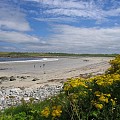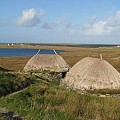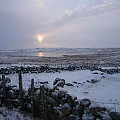


About the area
There have been people here in Shawbost almost as long as there have been people. The remains of ancient settlements have been unearthed at nearby Dalmore and shards of pottery from the Beaker Folk are still regularly unearthed along the shore and even in the local cemetery at Bragar.
The original Shawbost community lived hard by the beach, where the mounds of their tumbled homes can still be seen by the lane from South Shawbost. As they exhausted the nearby stocks of peat - their only fuel - the village moved progressively inland. New Shawbost, for instance, was laid out by Sir James Matheson only in 1850 and, a century later, a street of new houses was built up the hill at Grinnavat, South Shawbost.
Some traditional wells are still in use and are said to have healing powers; the remains of a circle of standing stones can be explored by Loch Raoinavat, as you leave South Shawbost, and - a much better known attraction - an ancient "Norse Mill" has been beautifully restored since the Second World War, and is clearly signposted near that same loch. This mill, and others, were still operating as recently as the 1930s.
In the late 1960s the then-headmaster led the pupils of Shawbost School in gathering artefacts for a splendid folk museum, housed for many years in the old Church of Scotland building; a selection of these are now on permanent display at The Old School Centre - Ionad Seann Sgoil - where you can also relax in the lovely atrium over a cup of tea, or explore the community garden.
This new community centre, the original village primary school, was renovated to the highest standard and opened in September 2005. Its facilities also include a fitness suite and the new Shawbost School - across the road and opened in 1993 - includes a swimming pool, which is open to the public; an especially welcome facility for visitors with young families.
Other Shawbost attractions include the lovely, curving beach with its clean silver sands - there is road access from either end; here, almost as soon as he could toddle, Rhoda's war-hero father, Angus Murray, learned his seamanship in a traditional open boat, fishing for lobsters with his uncle, Murchadh Mollan. In a relatively sheltered, horseshoe-shaped cove, it is a safe and pleasant beach for swimming.
All Shawbost is dominated by A' Bheinn Mhor, "The Mountain" - residents of a nearby township sweetly persist in calling it "Ben Bragar" - which is also readily approached by the old waterworks road out of New Shawbost. It's an easy climb and there are wonderful views to the Minch, the Eye Peninsula, west to the Flannan Isles and south to the hills of Uig and Harris.
For the still more active, fine surfing can be had at Dalmore beach - this is one of the most famous in Lewis, reached by a right-turn as you enter the village of Carloway. In certain conditions the thundering breakers at Dalmore can be heard at Shawbost itself. Almost as attractive is the smaller, more secluded bay at Dalbeag. Trout fishing is abundant on Lewis - and free in almost every instance; boat or game-fishing can be had by arrangement.
Local amenities include Shawbost Free Church, to which most villagers still adhere - there are services at 12 noon and 6 pm each Sunday, the morning service being usually bilingual and that at night in English. Shawbost Post Office sells a few very basic goods and an excellent shop at Barvas, the Welcome In Filling Station. They sell nearly everything including petrol and diesel.
40 NORTH FINE FOODS FROM THE CROFT KITCHEN






